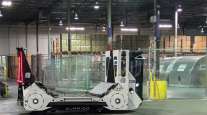Staff Reporter
DOT Launches AV TEST Initiative

[Stay on top of transportation news: Get TTNews in your inbox.]
The U.S. Department of Transportation has launched a program to increase transparency and inform members of the public about automated vehicle technologies.
DOT leaders introduced the Automated Vehicle Transparency and Engagement for Safe Testing (AV TEST) Initiative during a webinar June 15. The AV TEST initiative is meant to facilitate engagement among government leaders, industry representatives and members of the public. It also aims to increase transparency through an online platform for sharing automated driving system testing activities.
“Through this initiative, the department is creating a formal platform for federal, state and local governments and industry stakeholders,” Transportation Secretary Elaine Chao said.

Chao
Additionally, the initiative will incorporate online mapping tools to display testing locations at the national, state and local levels, as well as testing activity data, such as vehicle types and routes.
National Highway Traffic Safety Administration Deputy Administrator James Owens said AV TEST is open to all stakeholders involved in the safe development and testing of automated driving system vehicles. These participants may include departments of transportation, highway safety offices, city government agencies, manufacturers and operators.

COVID-19 has placed significant strain on many freight networks. So how are third-party logistics providers adapting to meet these challenges? Host Seth Clevenger chats with two 3PL executives who have had firsthand experience contending with this crisis. Hear a snippet, above, and get the full program by going to RoadSigns.TTNews.com.
So far, Owens said nine companies and eight states have committed to participating in the program. The participating companies are Beep, Cruise, Fiat Chrysler Automobiles, Local Motors, Navya, Nuro, Toyota, Uber and Waymo. The states involved are California, Florida, Maryland, Michigan, Ohio, Pennsylvania, Texas and Utah.
Owens said the initiative will serve an important role in educating members of the public about vehicles equipped with automated technology, the stakeholders involved in their development and the testing associated with these vehicles. He also noted that educating people about automated driving systems is key because there are many misconceptions surrounding such vehicles.
“These systems have the promise to help prevent fatal crashes, save lives and reduce crash severity,” Owens said. “Public trust will be the key to their adoption.”
Federal Highway Administrator Nicole Nason said automated vehicle technology may present benefits in terms of freight movement. The Federal Highway Administration has launched research initiatives related to automation issues, such as safety and operations.
“These are real truck drivers hauling real freight,” Nason said. “This will help us improve efficiency. [It’s] now more important than ever to exchange information with our stakeholders.”
NHTSA was criticized at a Nov. 19 National Transportation Safety Board hearing that was focused on a fatal 2018 pedestrian crash involving an Uber Technologies Inc. automated vehicle that occurred in Arizona. During the hearing, NTSB board member Jennifer Homendy said that while NHTSA may be issuing guidance related to automated vehicle testing, the agency is failing to establish firm testing standards.

Nason
DOT released its latest federal update of autonomous vehicle technology guidelines, known as AV 4.0, in January. Titled “Ensuring American Leadership in Automated Vehicle Technologies,” AV 4.0 is meant to act as a unifying set of principles across 38 federal departments, agencies, commissions and executive offices, and offers guidance to state and local government agencies, technology experts and industry representatives.
The guidelines were structured around U.S. AV technology principles, administration efforts to bolster AV technology growth and government opportunities for collaboration. AV 4.0 was designed to ensure a consistent regulatory approach, prioritize safety and promote innovation.
AV 4.0 builds on AV 3.0, the iteration of the guidelines that was released in October 2018. DOT’s previous guidance on automated driving systems, AV 2.0, was published in September 2017. During the June 15 webinar, DOT Deputy Assistant Secretary for Transportation Policy Finch Fulton described AV 2.0 as a “cornerstone of safety.”
Want more news? Listen to today's daily briefing:
Subscribe: Apple Podcasts | Spotify | Amazon Alexa | Google Assistant | More




